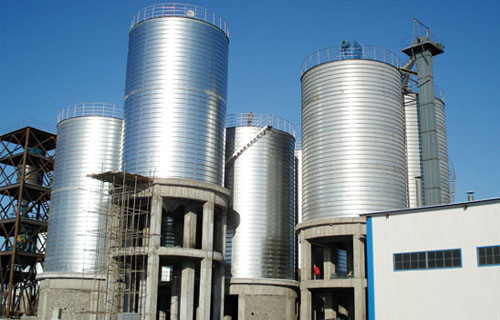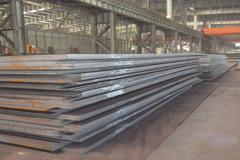Calcined Petroleum Coke Silo
Steel Silo System for Petcoke Storage

Body Structure of steel silo for petcoke storage
Our petcoke storage steel silo is composed of a concrete slip-formed silo shell, with the diameter ranges from 30m to 70m. The height of the petcoke storage silo varies from 30m up to 50m, which according to the soil conditions. The silo body is erected on a concrete foundation including a concrete reclaim tunnel and is covered by a structural steel roof. The in-feed conveyor is accommodated by the roof gallery. Through the transfer chute at the end of this infeed conveyor the bulk solid is transferred into the silo.
Central structure of petcoke storage steel silo
The central structure forms the connection between the static roof passage and the rotary silo mechanism. The central swivel is a steel structure that is suspended from the roof passage by a slewing ring. The slip ring body creates an electrical connection between the power source and the signal. The auger is suspended by a rotating bridge and a centrally structured wire. The auger can be raised and lowered by the winch system. In order to guide the incoming bulk material into the auger, the telescopic chute integration can be achieved in the central structure. The telescopic chute can be adjusted to a variable height between the bridge and the auger.
Slewing Bridge
The rotating double-sided bridge is supported at the wall by wheels on a crane track and mounted on the central slewing piece. It is welded steel structure of the bridge, and is driven by two slewing drive units. Each slewing drive consists of two frequency-controlled drives, which drive the wheels on the crane track.
Auger Frame
The auger frame is a welded structure that is suspended from the bridge by a wire rope at a central location. The frame is guided by the wheels on the silo wall. Two steel strands were installed under this structure. The optimized design of the screw conveyor is the result of the relationship between the diameter of the helix and the diameter of the silo. The screw machine transports the massive solids from the center to the wall and vice versa. Through the rotation of the helix, the bulk solids are evenly distributed over the large solid surface. After each rotation, the screw is lifted by the winch and the silo is filled layer by layer until the coal reaches its maximum level or begins to recover.
What’s Petroleum Coke?
Petroleum coke is a carbonaceous solid that delivered from oil refinery coker units or other cracking processes. The coking processes of producing petcoke contain coking, fluid coking, flexicoking and delayed coking. Traditionally, other coke has been delivered from coal. Large hydrocarbon molecules are cracked or broken down because of heat to produce “fuel grade” petcoke, a highly stable, solid fuel as well as other grades of petcoke. Petcoke is a valued commodity around the world and there has been a global market for petcoke for decades.
Types of Petroleum Coke
Needle coke, honeycomb coke, sponge coke and shot coke are four basic types of petroleum coke. Different types of petroleum coke have different microstructures due to differences in operating variables and nature of feedstock. Significant differences are also to be observed in the properties of the different types of coke, particularly ash and volatile matter contents.
Production Process of Petcoke
There are two grades of petroleum coke, namely fuel grade which is high in sulfur and metals and anode grade that low in sulfur and metals. The raw coke directly out of the coker is often referred to as green coke. That means green coke is unprocessed. The further processing is calcining the petcoke in a rotary kiln removes residual volatile hydrocarbons from the coke. In an anode baking oven to process the calcined petroleum coke further in order to produce anode coke of the desired shape and physical properties which are mainly used in aluminium and steel industry.


